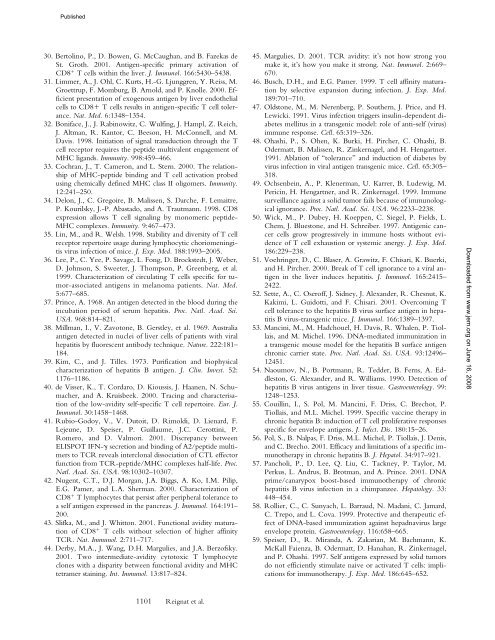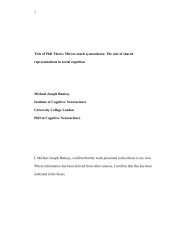Escaping High Viral Load Exhaustion: CD8 Cells with Altered ...
Escaping High Viral Load Exhaustion: CD8 Cells with Altered ...
Escaping High Viral Load Exhaustion: CD8 Cells with Altered ...
You also want an ePaper? Increase the reach of your titles
YUMPU automatically turns print PDFs into web optimized ePapers that Google loves.
Published<br />
30. Bertolino, P., D. Bowen, G. McCaughan, and B. Fazekas de<br />
St. Groth. 2001. Antigen-specific primary activation of<br />
<strong>CD8</strong> T cells <strong>with</strong>in the liver. J. Immunol. 166:5430–5438.<br />
31. Limmer, A., J. Ohl, C. Kurts, H.-G. Ljunggren, Y. Reiss, M.<br />
Groettrup, F. Momburg, B. Arnold, and P. Knolle. 2000. Efficient<br />
presentation of exogenous antigen by liver endothelial<br />
cells to <strong>CD8</strong> T cells results in antigen-specific T cell tolerance.<br />
Nat. Med. 6:1348–1354.<br />
32. Boniface, J., J. Rabinowitz, C. Wulfing, J. Hampl, Z. Reich,<br />
J. Altman, R. Kantor, C. Beeson, H. McConnell, and M.<br />
Davis. 1998. Initiation of signal transduction through the T<br />
cell receptor requires the peptide multivalent engagement of<br />
MHC ligands. Immunity. 998:459–466.<br />
33. Cochran, J., T. Cameron, and L. Stern. 2000. The relationship<br />
of MHC-peptide binding and T cell activation probed<br />
using chemically defined MHC class II oligomers. Immunity.<br />
12:241–250.<br />
34. Delon, J., C. Gregoire, B. Malissen, S. Darche, F. Lemaitre,<br />
P. Kourilsky, J.-P. Abastado, and A. Trautmann. 1998. <strong>CD8</strong><br />
expression allows T cell signaling by monomeric peptide-<br />
MHC complexes. Immunity. 9:467–473.<br />
35. Lin, M., and R. Welsh. 1998. Stability and diversity of T cell<br />
receptor repertoire usage during lymphocytic choriomeningitis<br />
virus infection of mice. J. Exp. Med. 188:1993–2005.<br />
36. Lee, P., C. Yee, P. Savage, L. Fong, D. Brockstedt, J. Weber,<br />
D. Johnson, S. Sweeter, J. Thompson, P. Greenberg, et al.<br />
1999. Characterization of circulating T cells specific for tumor-associated<br />
antigens in melanoma patients. Nat. Med.<br />
5:677–685.<br />
37. Prince, A. 1968. An antigen detected in the blood during the<br />
incubation period of serum hepatitis. Proc. Natl. Acad. Sci.<br />
USA. 968:814–821.<br />
38. Millman, I., V. Zavotone, B. Gerstley, et al. 1969. Australia<br />
antigen detected in nuclei of liver cells of patients <strong>with</strong> viral<br />
hepatitis by fluorescent antibody technique. Nature. 222:181–<br />
184.<br />
39. Kim, C., and J. Tilles. 1973. Purification and biophysical<br />
characterization of hepatitis B antigen. J. Clin. Invest. 52:<br />
1176–1186.<br />
40. de Visser, K., T. Cordaro, D. Kioussis, J. Haanen, N. Schumacher,<br />
and A. Kruisbeek. 2000. Tracing and characterisation<br />
of the low-avidity self-specific T cell repertoire. Eur. J.<br />
Immunol. 30:1458–1468.<br />
41. Rubio-Godoy, V., V. Dutoit, D. Rimoldi, D. Lienard, F.<br />
Lejeune, D. Speiser, P. Guillaume, J.C. Cerottini, P.<br />
Romero, and D. Valmori. 2001. Discrepancy between<br />
ELISPOT IFN- secretion and binding of A2/peptide multimers<br />
to TCR reveals interclonal dissociation of CTL effector<br />
function from TCR-peptide/MHC complexes half-life. Proc.<br />
Natl. Acad. Sci. USA. 98:10302–10307.<br />
42. Nugent, C.T., D.J. Morgan, J.A. Biggs, A. Ko, I.M. Pilip,<br />
E.G. Pamer, and L.A. Sherman. 2000. Characterization of<br />
<strong>CD8</strong> T lymphocytes that persist after peripheral tolerance to<br />
a self antigen expressed in the pancreas. J. Immunol. 164:191–<br />
200.<br />
43. Slifka, M., and J. Whitton. 2001. Functional avidity maturation<br />
of <strong>CD8</strong> T cells <strong>with</strong>out selection of higher affinity<br />
TCR. Nat. Immunol. 2:711–717.<br />
44. Derby, M.A., J. Wang, D.H. Margulies, and J.A. Berzofsky.<br />
2001. Two intermediate-avidity cytotoxic T lymphocyte<br />
clones <strong>with</strong> a disparity between functional avidity and MHC<br />
tetramer staining. Int. Immunol. 13:817–824.<br />
45. Margulies, D. 2001. TCR avidity: it’s not how strong you<br />
make it, it’s how you make it strong. Nat. Immunol. 2:669–<br />
670.<br />
46. Busch, D.H., and E.G. Pamer. 1999. T cell affinity maturation<br />
by selective expansion during infection. J. Exp. Med.<br />
189:701–710.<br />
47. Oldstone, M., M. Nerenberg, P. Southern, J. Price, and H.<br />
Lewicki. 1991. Virus infection triggers insulin-dependent diabetes<br />
mellitus in a transgenic model: role of anti-self (virus)<br />
immune response. Cell. 65:319–326.<br />
48. Ohashi, P., S. Ohen, K. Burki, H. Pircher, C. Ohashi, B.<br />
Odermatt, B. Malissen, R. Zinkernagel, and H. Hengartner.<br />
1991. Ablation of “tolerance” and induction of diabetes by<br />
virus infection in viral antigen transgenic mice. Cell. 65:305–<br />
318.<br />
49. Ochsenbein, A., P. Klenerman, U. Karrer, B. Ludewig, M.<br />
Pericin, H. Hengartner, and R. Zinkernagel. 1999. Immune<br />
surveillance against a solid tumor fails because of immunological<br />
ignorance. Proc. Natl. Acad. Sci. USA. 96:2233–2238.<br />
50. Wick, M., P. Dubey, H. Koeppen, C. Siegel, P. Fields, L.<br />
Chem, J. Bluestone, and H. Schreiber. 1997. Antigenic cancer<br />
cells grow progressively in immune hosts <strong>with</strong>out evidence<br />
of T cell exhaustion or systemic anergy. J. Exp. Med.<br />
186:229–238.<br />
51. Voehringer, D., C. Blaser, A. Grawitz, F. Chisari, K. Buerki,<br />
and H. Pircher. 2000. Break of T cell ignorance to a viral antigen<br />
in the liver induces hepatitis. J. Immunol. 165:2415–<br />
2422.<br />
52. Sette, A., C. Oseroff, J. Sidney, J. Alexander, R. Chesnut, K.<br />
Kakimi, L. Guidotti, and F. Chisari. 2001. Overcoming T<br />
cell tolerance to the hepatitis B virus surface antigen in hepatitis<br />
B virus-transgenic mice. J. Immunol. 166:1389–1397.<br />
53. Mancini, M., M. Hadchouel, H. Davis, R. Whalen, P. Tiollais,<br />
and M. Michel. 1996. DNA-mediated immunization in<br />
a transgenic mouse model for the hepatitis B surface antigen<br />
chronic carrier state. Proc. Natl. Acad. Sci. USA. 93:12496–<br />
12451.<br />
54. Naoumov, N., B. Portmann, R. Tedder, B. Ferns, A. Eddleston,<br />
G. Alexander, and R. Williams. 1990. Detection of<br />
hepatitis B virus antigens in liver tissue. Gastroenterology. 99:<br />
1248–1253.<br />
55. Couillin, I., S. Pol, M. Mancini, F. Driss, C. Brechot, P.<br />
Tiollais, and M.L. Michel. 1999. Specific vaccine therapy in<br />
chronic hepatitis B: induction of T cell proliferative responses<br />
specific for envelope antigens. J. Infect. Dis. 180:15–26.<br />
56. Pol, S., B. Nalpas, F. Driss, M.L. Michel, P. Tiollais, J. Denis,<br />
and C. Brecho. 2001. Efficacy and limitations of a specific immunotherapy<br />
in chronic hepatitis B. J. Hepatol. 34:917–921.<br />
57. Pancholi, P., D. Lee, Q. Liu, C. Tackney, P. Taylor, M.<br />
Perkus, L. Andrus, B. Brotman, and A. Prince. 2001. DNA<br />
prime/canarypox boost-based immunotherapy of chronic<br />
hepatitis B virus infection in a chimpanzee. Hepatology. 33:<br />
448–454.<br />
58. Rollier, C., C. Sunyach, L. Barraud, N. Madani, C. Jamard,<br />
C. Trepo, and L. Cova. 1999. Protective and therapeutic effect<br />
of DNA-based immunization against hepadnavirus large<br />
envelope protein. Gastroenterology. 116:658–665.<br />
59. Speiser, D., R. Miranda, A. Zakarian, M. Bachmann, K.<br />
McKall Faienza, B. Odermatt, D. Hanahan, R. Zinkernagel,<br />
and P. Ohashi. 1997. Self antigens expressed by solid tumors<br />
do not efficiently stimulate naive or activated T cells: implications<br />
for immunotherapy. J. Exp. Med. 186:645–652.<br />
Downloaded from www.jem.org on June 16, 2008<br />
1101 Reignat et al.
















